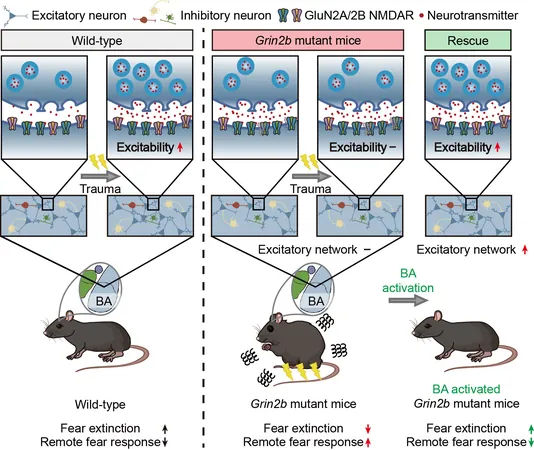
Unlocking the Brain: How an Autism Mutation Leads to PTSD-like Fear Responses
2025-09-18
Author: John Tan
The Overlooked Connection Between Autism and PTSD
Many know autism spectrum disorder (ASD) for its hallmark traits such as challenges in social interaction and repetitive behaviors. However, a hidden crisis lies within; nearly 40% of children with ASD grapple with anxiety disorders, often exhibiting heightened fear responses that mimic symptoms of post-traumatic stress disorder (PTSD). Emerging theories suggest that individuals with ASD may struggle to erase traumatic fear memories, leaving them vulnerable even after the threat has subsided.
Groundbreaking Findings on Brain Function and Fear
In a pioneering study led by Professor Kim Eunjoon at the Institute for Basic Science, researchers have unlocked the mystery behind the ASD-related mutation in the Grin2b gene. This mutation, affecting the GluN2B subunit of NMDA receptors, disrupts critical brain circuits responsible for extinguishing fear memories. Published in Science Advances, this research marks a significant breakthrough in understanding the link between autism and PTSD.
Fear Memories: The Unlearned Lesson
Utilizing a mouse model with a human ASD mutation in Grin2b, the team discovered that these mice could learn fear effectively following a traumatic incident, yet they were unable to unlearn that fear. This inability to extinguish fear responses led to long-lasting reactions akin to PTSD. Through intricate brain mapping, it became evident that the basal amygdala (BA), a crucial area for fear memory extinction, went silent after trauma in these mutant mice.
Silencing the Amygdala: The Key to Understanding PTSD-like Symptoms
Kim articulated, "These animals could learn fear just fine, but they couldn't unlearn it. The amygdala essentially shut down when it was needed most, locking the traumatic memory in place." Further investigations revealed that excitatory neurons in the BA of mutant mice displayed suppressed activity post-trauma, hindering the brain's ability to erase fear.
Reversing the Effects: A Journey Towards Therapy
To confirm that this neuronal silencing caused PTSD-like behaviors, researchers employed chemogenetic tools to reactivate BA neurons during fear extinction training. The results were astonishing—normalizing neuronal activity and successfully rescuing long-term fear responses. Co-first author Kang Muwon stated, "Reactivating those neurons could reverse the behavioral and physiological abnormalities. This silenced amygdala is critical for understanding PTSD-like symptoms in our model."
A Clear Path Forward
This groundbreaking study not only illustrates the molecular and circuit-level mechanisms behind PTSD-like symptoms in autism but also opens the door to future therapeutic interventions. With plans to delve deeper into gene expression changes and explore receptor-specific agonists targeting GluN2B-containing NMDA receptors, researchers are poised to shed even more light on these complex pathways.
Bridging the Gap from Observation to Understanding
Professor Kim remarked, "This work bridges a crucial gap, moving from anecdotal reports of trauma vulnerability in autism to a clear mechanistic understanding of why it happens, and even demonstrating that it can be reversed in a model system." The future holds promise as this research may pave the way for innovative treatments that could greatly enhance the quality of life for individuals struggling with autism and PTSD-like symptoms.



 Brasil (PT)
Brasil (PT)
 Canada (EN)
Canada (EN)
 Chile (ES)
Chile (ES)
 Česko (CS)
Česko (CS)
 대한민국 (KO)
대한민국 (KO)
 España (ES)
España (ES)
 France (FR)
France (FR)
 Hong Kong (EN)
Hong Kong (EN)
 Italia (IT)
Italia (IT)
 日本 (JA)
日本 (JA)
 Magyarország (HU)
Magyarország (HU)
 Norge (NO)
Norge (NO)
 Polska (PL)
Polska (PL)
 Schweiz (DE)
Schweiz (DE)
 Singapore (EN)
Singapore (EN)
 Sverige (SV)
Sverige (SV)
 Suomi (FI)
Suomi (FI)
 Türkiye (TR)
Türkiye (TR)
 الإمارات العربية المتحدة (AR)
الإمارات العربية المتحدة (AR)